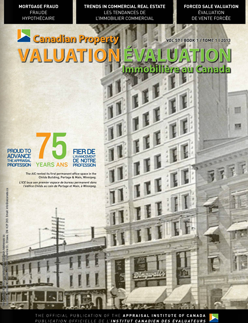Forced Sale Valuation
Canadian Property Valuation Magazine
Search the Library Online
By Iain Hyslop, AACI, P. App.
Volunteer Chair, Standards Sub-Committee
Requests for appraisals with the estimated value to be based on a ‘forced sale’ premise are common. These requests are usually to assume a shorter than typical marketing period, sometimes with limited marketing efforts. Although these tend to occur more often in declining real estate markets, they can arise for a number of reasons.
Situations involving property owners wishing to sell quickly for reasons of financial distress, to satisfy a legal claim, or simply to liquidate in order to move can result in a request to provide a forced sale valuation. However, typical requests are generally from lenders undertaking a foreclosure action or seeking a court ordered sale. In these situations, the objective may be recovery of an outstanding mortgage balance rather than obtaining market value, avoiding loss in value during a declining market, limiting further loss and mitigating additional costs associated with a prolonged marketing period, or all of these.
It is important to understand that, despite these differences in comparison to an unconstrained market value appraisal, valuation principles and market value remain fundamental. The term ‘forced sale value’ is not a concept separate from market value, but it simply implies a form of marketing conditions that are less favourable to the seller than those set out in the definition of market value and usually requiring hypothetical conditions and extraordinary assumptions. Further to this premise, in circumstances involving financial distress, the party being forced to sell may be an unwilling seller, hence creating circumstances where the seller is in a disadvantaged bargaining position contrary to the willing buyer/willing seller concept.
The most common hypothetical conditions and extraordinary assumptions arise from the requirement that the property be sold within an unusually short period, thereby limiting reasonable market exposure and recognizing the specific needs of a party other than the property owner. In these circumstances, proper marketing may not be possible.
The term ‘forced sale value’ is loosely used. There is no recognized definition, however, ‘liquidation value’ and ‘distress sale’ are generally synonymous with the concept of forced sale, whereby all imply a reduced sale period and a compulsion to sell.
Dealing with requests for forced sale valuations can be tricky. Care must be taken to first have clear terms of reference with the client and second to create a report that does not have misleading content or results, or appear to favour the client. Initial discussions should include an understanding of the objectives of the client and reasons why a forced sale value is required. In this regard, it is wise to have an agreement specifically identifying the proposed marketing period upon which the value estimate is to be based. Even for a forced sale valuation, the proposed marketing period must be reasonable.
Terms of reference should be clearly outlined in the report, with an adequate discussion of market value and how the selling circumstances as assumed in the report differ from actual conditions, along with reasons for the proposed forced sale. A bold statement to the effect that the reported value is not market value would be advisable. CUSPAP practice note 12.16.6 states, “An appraisal assignment for an estimate of value other than market value could be misleading if prepared in isolation without reference to market value.”
With respect to the valuation process, appropriate methodology should start with an estimate of market value based upon normal circumstances. A discount factor can be developed on the basis of prevailing market conditions including the extent of competitive properties listed for sale, the length of market exposure of existing listings, trends in terms of whether the number of competitive listings are increasing or declining, and whether sales activity can be projected to be increasing or decreasing. Reference can be made to transactions that occurred under forced sale circumstances, however, these should be used with caution and thoroughly investigated.
These types of assignments can also be challenging if the property has been neglected or is deteriorating.
Assignments requiring forced sale valuations must be considered carefully before being accepted. All limitations, assumptions and statements regarding market value and deviations from market value should be communicated clearly and be readily evident to any reader of the appraisal report.
Recognizing that valuations prepared on this basis are often submitted to court, and that a forced sale value could appear to be biased in favour of the seller over the property owner, it is even more important that reasoning and conclusions outlined in the report be well supported.
These types of assignments can easily present unforeseen problems, hence, clarity in all aspects of the appraisal process from initial instructions to completion of the report will also help to reduce the possibility of a claim against the Professional Liability Insurance Fund.
Important CUSPAP references are as follows:
Definition 2.58 – Value…In appraisal practice value must always be qualified, e.g. – market value, liquidation value, investment value, rental value.
Appraisal Standards Rule 6.2.6 – Provide an analysis of reasonable exposure time limited to a market value opinion.
Appraisal Standards Comment 7.7 – Exposure time
Practice Note 12.16 – Value
Practice Note 12.20 – Exposure time
Practice Note 12.31.2 – Extraordinary assumptions
Members are also encouraged to refer to the Claims Prevention Bulletin on Power of Sale Appraisals in the Members Section of the AIC website.





